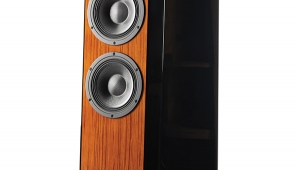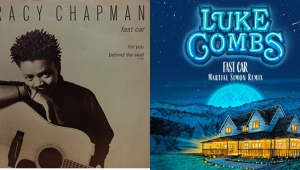| Columns Retired Columns & Blogs |
The Waveform Loudspeaker
John Ötvös, the father of Waveform Research Inc. and The Waveform Loudspeaker, hesitates not at inviting ultracritical examination: "The Waveform is the most accurate, the best, forward-firing loudspeaker in the world." Period. Reviewers, of course, welcome such statements, and I'll be examining that one, but I'll also try to answer the inherent reviewing question of whether the Waveform is a good place for you to park $9800 on your way to "the highest of high-end sound" (that was our slogan for the first Santa Monica High End Hi-Fi Show).
Footnote 1: The rationale for this terminology is that the control is there to correct for excessive coupling between the unusual level of bass response the Waveform offers and the different rooms in which it will be used. Higher numbers therefore indicate more coupling—which has to be diminished. Get it?
The company
Without a doubt, one of the first questions I'd ask myself is whether the company asking for my $9800 had proved itself in the high-end wars—what were the chances that my dealer would still be selling this expensive product two years from now, or, more ultimately, that this little-known speaker company would still exist?
Given the small number of US outlets for the Waveform (Absolute Audio in Orange County and Keith Yates Audio in Sacramento), the former question might well be answered simply by interviewing the dealers involved. Though their powers of prediction aren't perfect, I'm sure you could get an idea just by talking to Evelyn Sinclair or Keith Yates. And, of course, Stereophile reviewers aren't given to clairvoyance as to the survival of companies, though we'd like that ability—some of the products we've rated most highly have been produced by people just starting out who've struggled for at least a couple of years. (Not that this is the ultimate bad sign—companies like Audio Research, Conrad-Johnson, and Thiel stayed small for significant periods of time, only to burgeon into card-carrying members of the audio establishment in later years.)
Still, I would want to be careful. Since 1987, when they were introduced, just 17 pairs of Waveforms have been built, and it's the only loudspeaker made by Waveform Research. Although this represents almost a quarter-million dollars at retail (many of the first ones were made of solid black cherry, and sold for $17,000/pair), Waveform's feet are just getting wet in the speaker business.
Mr. Ötvös himself is not so inexperienced. He has been a master cabinet-builder and woodworker running his own business for upward of 20 years, and self-admittedly is not the design genius behind this loudspeaker. That said, I got the distinct impression that he is its "father," and in more than just a commercial sense: He employed Paul Barton of PSB to design the Waveforms (see Vol.11 No.5 for JGH's review of the first PSB loudspeaker sold in the US); he determined the unusual shape of the speaker; and I am sure he decided where the emphases should lie. John Ötvös is a direct, self-assured man (see the quote that begins this review) with every intention of making it in the ultra-high-end speaker business; I respect his determination.
The design
But what of his speaker? All products in this price range demand that you go the extra mile in setting them up and choosing your associated components, and the Waveform is no exception. Like the IRS Betas, the Waveforms require two high-powered stereo amplifiers. Canadian loudspeaker manufacturers, who so frequently come from the discipline of NRC (National Research Council of Canada) testing—with its insistence on blind evaluation of everything—ön't like to talk about the importance of amplifiers chosen for use with their loudspeakers, but I found both the Waveform and the Mirage (see review in Vol.12 No.6) to be significantly amplifier-sensitive. The Waveform, in addition, requires significant power-handling capability—not so much because it's inefficient (90dB/1W/1m is awfully good for a high-end speaker), but because of the room you will likely want to use it in, and the volume levels you'll want to experience to take advantage of its unique capabilities. It's possible to drive the Waveforms with a pair of under-$1000 amplifiers, but you'll be a lot happier with a pair that run $6000–$10,000 each, I promise you.
In appearance, the Waveforms are at first off-putting: both base and top are irregular octagons (you might think of them as rectangles with mildly truncated corners), the larger base tapering to the smaller top. The front baffle, in which all drivers are mounted, is an almost triangular trapezoid with base and top parallel (see photo). My pair was finished in black plastic not dissimilar to what Thiel used in the review pair of CS1.2s I had, and to what Mirage use in their M-1s. Somehow, the Waveform black plastic has more of a luster—the Thiel and Mirage plastic is mirror-like in finish, where the Waveform has a very fine "orange-peel" (to use an automotive term) texture that is more sensuous and "thick." Overall, the Waveforms cut an imposing figure: squat, heavy (though the manufacturer claims the same weight as the Mirage M-1, they were at least twice as difficult to move around), and sensuously black.
Given this unusual design, I was solicitous of opinions from visitors during the Waveforms' stay chez moi, and the results were mixed. There were a few denunciations ("ugly"), quite a few noncommittal responses, and at least one rave. Though at first repelled, I gradually came to like them, though the obligatory more-or-less corner placement left them more in the way—and it's impossible to ignore them—than I liked. For many people the near-wall placement will be more convenient.
Part of my liking them, and part of my frustration, came from reading the owner's manual. Throughout the manual (produced, it would seem, once and for all in 1987) the speaker is referred to not as the black plastic-finished monolith described above, but as a sensuous chunk of furniture made from 2"-thick black cherry—in fact, much of the manual deals with care of the wood surface! This obviously reflects John Ötvös's woodworking background, as well as his tremendous personal involvement in the product—much as if he's describing the care and handling of his child (accurate, if he's like most speaker designers)! For me, this led to frustration. Though Ötvös explained that doing the black-cherry version would cost at least $30,000/pair at today's wood and woodworking prices, I couldn't help but see the Waveform as an intensely elaborated physical object whose soul (in the black plastic version) had been taken away. I'm one of those who was raised on the spiritual values of wood grains—and at $9800 this is a self-indulgence I'd like to see indulged!
It hardly needs be said that, even in black plastic, the Waveform is exquisitely crafted. These days people like to talk about how superbly Japanese automobiles are finished. And they are, for the late 20th century. However, they still don't hold a candle, mass-produced as they are, to the interior of a pre-1972 Mercedes, Jaguar, or Rolls (or, for that matter, a Japanese handmade sword or wooden comb). The Waveforms come from this latter tradition—I yearn to see a pair in black cherry.
Speaking of the owner's manual, it provided me with all the detail that Mirage omitted from theirs. The speaker is thoroughly discussed technically, as are set-up possibilities for various-size rooms, frequency responses and impedances are graphed, and an elaborate table for amplifier gain-matching is there to boggle the mind (of questionable utility, too, as we shall see). There are even the obligatory laudatory comments from other manufacturers and Digital Audio. But, though John Ötvös obviously labors over the appearance of his loudspeakers, where is his respect for production values when it comes to the printed word? The "Owner's Manual" consists of 23 Xeroxed sheets with 8 different typefaces (not counting the reprint from Digital Audio, and the graphs), many of them badly produced on a laser printer (yeccchhh). Why must "high-end" audio companies keep stubbing their toes on such simple matters as presentation? After all, you're not asking a guy to spend $400 on this product. Would he buy a car that put out an owner's manual like this? Wake up, Mr. Ötvös. Wake up, industry!
Another toe-stub came with the active equalizer used to split the signal between the 15" woofer and the rest of the system (mid-to-tweeter and tweeter-to-supertweeter crossovers are accomplished passively). This reasonably well-constructed 19"x10"x2" black box actually performs two functions. In addition to dividing low and high, it provides equalization (called "coupling") for the bottom octave of response (it seemed to affect the range below 35Hz). Confusingly, you choose higher numbers (greater rotation clockwise on the knob) to get less low bass (footnote 1). But that wasn't the toe-stub; it was the fact that the holes in the back of the equalizer were too small to accommodate most high-end interconnects. (The RCA phono jacks are mounted directly to the crossover's circuit board, inside the chassis. Ergo, there have to be holes in the chassis for the interconnects to fit through.) Sears sold me a reamer adequate for making the holes bigger, but that plus the necessary dressing of the hole edges was a pain and made the crossover cover significantly less attractive.
Mr. Ötvös says that all future crossover chassis will have adequately sized holes, but it's indicative of Waveform's tiny production that they've not been compelled until now to acknowledge the widespread change in the dimensions of high-end interconnect terminations (a change which, as far as I know, has no compelling justification other than marketing).
Footnote 1: The rationale for this terminology is that the control is there to correct for excessive coupling between the unusual level of bass response the Waveform offers and the different rooms in which it will be used. Higher numbers therefore indicate more coupling—which has to be diminished. Get it?
- Log in or register to post comments




































